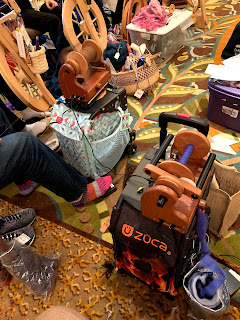What began in 1989 as a small group of 8 spinners who just wanted to gather in
January and have a spinning retreat--has now gone to over 125 spinners plus
vendors coming together the last full weekend in January. We begin
on Wednesday with vendors setting up their booths with registrants
arriving at 1 PM--they are usually waiting in the hallway rather
impatiently to enter.
the doors open and the spinners begin!
It's the best laid back place to be for three and half days--there
are no workshops or seminars, just spinners making new friends,
greeting 'old' friends and spinning to their heart's content.
You can stay as late as you want, then back to their condo
to rest to begin again the next day.


One of the vendors has the best designed
booth-always intriguing and usually to the theme--this year's theme "Helping Hands"
This year the vendor's display was with these wonderful overshot coverlets! All dyed with
indigo--just a delight to see and touch. I'm sorry I didn't get a photo of their completed booth set-up
Every one of these spinners are wearing a handmade item--either handspun or not--it doesn't matter--
Lovely it is for body adornment!
Each day around 10 AM--give or take 30 minutes or more--there is a show and
tell and we encourage anyone who wishes to talk about and show off their
latest creation. We have some wonderful knitters amongst these spinners.
Around the room, there are various sizes of circles--some large, some small, but each spinning away on their purchased product--
Doesn't matter how experienced or novice you are, there is always something to learn from each other--that's why there are no workshops or seminars.
Gorgeous colors flow throughout the days--natural dyes along with chemical dyes--all brightly shining with eager hands spinning away.
Several of our spinners are also knitters and weavers--so here are the latest in color study from Charlene--I loved this study--constant warp with weft of warp colors crossing over--
great way to see how some colors fool the eye --no mudding here or there!


I was surprised how many E-spinners were being used--no electric cords allowed-- But
the "old" fashion way of treadling was majority
Since our theme for 2020 was Helping Hands--we had collected handmade items from those
who wished to participate. There were many who donated their items to their local
charity, but this group of hats, gloves, scarves, lap robes and blankets were going to a
northern state--in the South we have only 3-4 days of cold a year
We did not count the total number of gifted handmade presented--wonderful
contribution from our "helping hands" spinners
Another year has come to a close for our gathering--it is with sadness we hug and say goodbye to our friends--we'll see you next year in 2021! Our theme was voted by our
participants--"Alpacalypse is coming"--what fun will we have with this!

















































